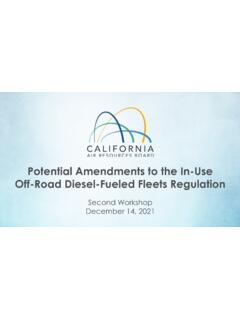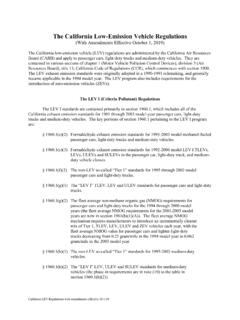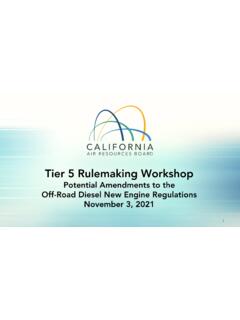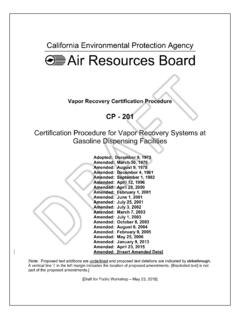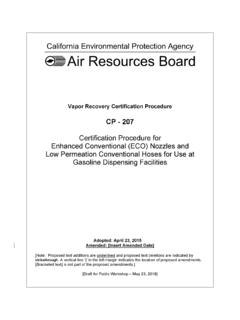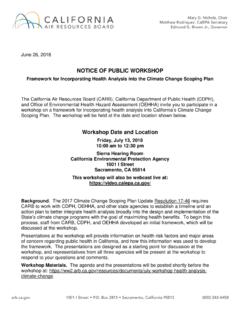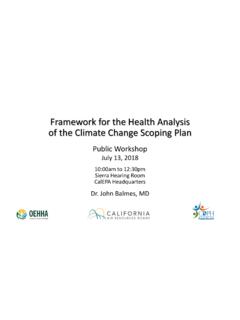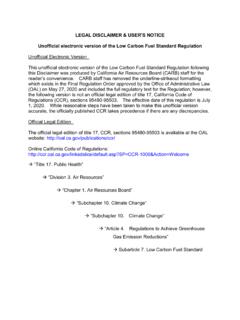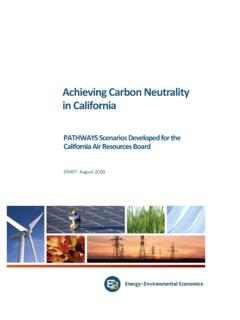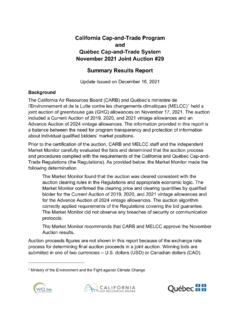Transcription of CCS Protocol Under the Low Carbon Fuel Standard
1 Carbon Capture and Sequestration Protocol Under the Low Carbon fuel Standard August 13, 2018 This Page Left Intentionally Blank TABLE OF CONTENTS A. DEFINITIONS AND 7 1. Applicability .. 7 2. Definitions and 7 B. ACCOUNTING REQUIREMENTS FOR CCS PROJECTS Under THE 1. System 2. Quantification of Geologic Sequestration CO2 Emission Reductions .. 24 Covered Greenhouse Gas Emissions for the LCFS .. 24 Greenhouse Emissions Reductions 3. Invalidation and Buffer 29 C.
2 PERMANENCE REQUIREMENTS FOR GEOLOGIC 31 1. Permanence Certification of Geologic Carbon Sequestration Projects .. 31 Application and Certification .. 31 Third Party Certification Application 35 Recordkeeping ..39 Terms and Conditions .. 39 2. Site Minimum Site Selection 40 Risk Geologic and Hydrologic Evaluation 42 Testing and Well Logging Program ..47 Storage Complex Delineation and Corrective 52 Storage Complex Delineation using Computational Modeling Corrective Action Plume Extent Reevaluation ..64 Baseline Testing and Monitoring .. 66 3. Well Construction and Operating Requirements.
3 68 Well Construction .. 68 Pre-Injection 72 Injection Well Operating Requirements .. 73 Operating Restrictions and Incident Response .. 75 4. Injection Monitoring Testing and Mechanical Integrity Mechanical Integrity Tests ..82 Loss of Mechanical CCS Project Monitoring .. 83 Emissions Monitoring, Measurement, and Verification of 5. Well Plugging and Abandonment and Post-Injection Site Care and Site Closure . 99 Well Plugging and Abandonment .. 99 Post-Injection Site Care and Site Closure.
4 102 6. Emergency and Remedial Emergency and Remedial Response 7. Financial 110 8. Modification or Revocation and Reissuance of Permanence Certification .. 116 Termination of Permanence 118 Minor Modification of Permanence Certifications .. 118 9. Legal Understanding, Contracts, and Post-Closure Care .. 119 Appendix A. Fugitive and Vented GHG Emissions: Injection into Depleted Oil and Appendix D. Data Measurement/Generation and Reporting for Energy and Chemical Appendix G. Determination of a CCS Project s Risk Rating for Determining its Gas and Saline 121 Appendix B. CO2 Venting and Fugitive Emissions from CO2-EOR Operations.
5 123 Appendix C. Converting Volume of CO2 to Mass .. 125 Inputs .. 127 Appendix E. Emission Factors and Component Appendix F. Emissions from CO2 Entrained in Produced Oil and Contribution to the LCFS Buffer Account .. 137 FIGURES Figure 1. System boundary for CO2 capture and sequestration in oil and gas reservoirs used for 22 Figure 2. System boundary for CO2 capture and sequestration in depleted oil and gas reservoirs and saline formations.. 23 Figure 3. CCS Protocol certification, operation, and closure process.. 31 Figure 4. Flow chart showing the process for CCS project design.
6 52 Figure 5. Well evaluation flow 61 TABLES Table 1. Risk scenario 41 Table 2. Degrees of risk for emergency Carbon CAPTURE AND SEQUESTRATION Protocol Under THE LOW Carbon fuel Standard A. DEFINITIONS AND APPLICABILITY 1. Applicability The Carbon Capture and Sequestration (CCS) Protocol applies to CCS projects that capture Carbon dioxide (CO2) and sequester it onshore, in either saline or depleted oil and gas reservoirs, or oil and gas reservoirs used for CO2-enhanced oil recovery (CO2-EOR).
7 The CCS Protocol applies to both new and existing CCS projects, provided the projects meet the requirements for permanence pursuant to section C of this Protocol . 2. Definitions and Acronyms (a) Definitions: For purposes of this document, the definitions in title 13, California Code of Regulations, section 95481 apply, except as otherwise specified in the document. The following definitions also apply to this document: (1) Active life or operational life means the operational phase of a CCS project in which injection and, if applicable, production occurs. The term omits the monitoring and site care phase of the CCS project following injection completion.
8 (2) Aqueous diffusion coefficient is the magnitude of the molar flux through a surface per unit concentration gradient. Typical diffusion coefficients for organic compounds in aqueous solution range between 10-10 to 10-9 m2/s. (3) Artificial penetration means any man-made structures, such as wells or mines, which provide a flow path out of the sequestration zone or storage complex. (4) Assets means all existing and all probable future economic benefits obtained or controlled by a particular entity. (5) Biogenic CO2 refers to CO2 produced from biomass. (6) Borehole means a cylindrical hole cut into rock or soil by drilling.
9 Also refers to the inside diameter of the wellbore wall ( , the rock face that bounds the drilled hole). (7) Bottom-hole pressure means the pressure at the bottom of the wellbore within the sequestration zone. It may be measured directly with a downhole pressure transducer, or in some cases estimated from the surface pressure and the height and density of the fluid column. CCS Protocol A: Definitions and Applicability Page 7/ 139 (8) Brine is water containing dissolved minerals and inorganic salts in solution, including sodium, calcium, or bromides.
10 Water containing dissolved solids in excess of 100 g/L is classified as brine. Large quantities of brine are often produced along with oil and gas. (9) Brittleness is a property of a rock in which failure Under a load occurs by fracturing, rather than by plastic deformation. (10) Capillary pressure means the pressure difference across the interface of two immiscible fluids ( , CO2 and water). (11) Capillary entry-pressure means the pressure that a non-wetting fluid ( CO2) must overcome to displace water held tightly by capillary forces in the pores of a rock or sediment. (12) Capture Facility Operator means the operator responsible for the CCS capture facility.
